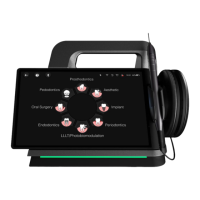Surfaces can absorb laser energy. This can cause the surface temperature
to rise and ignite the material.
Never use the S3 in explosive areas or direct the laser beam in the
direction of flammable materials.
Never use flammable substances for anaesthesia during the laser
procedure
Never use the laser device in the presence of anaesthetics that are
flammable when in contact with air, oxygen (O
2
) and, nitrogen dioxide
(NO
2
) since these gases can increase the strength and extent of a fire.
Flammable solvents and liquids used for cleaning and disinfecting the
laser device shall be allowed to evaporate / volatize, before working
with the laser.
If flammable materials are necessary during the procedure, ensure they
are kept wet.
Materials such as cotton which is an oxygen saturated material can be
flammable during normal laser use.
Observe all fire hazards caused by flammable gases. Endogenous
gases can explode.
Be particularly careful when using oxygen since oxygen can increase
the strength and extent of a fire.
Maintain fire extinguishing equipment near the procedural room.
The area in which the maximum permissible radiation can be exceeded
from the "laser procedure area" must be delimited and identified by a laser
warning sign.
Entrances shall be posted with the triangular laser warning sign.
The NOHD (Nominal Ocular Hazard Distance) from the laser is 2.5m.
An additional laser warning sign must be provided by the manufacturer with
each laser system. We recommend affixing a sign to the entrance of the
laser procedure room to warn entering persons of the laser in the room.

